
You've got to steer the car with something, and even in Stock class you can change the wheel as long as you don't change it much. The steering columns had several changes over the years, if you intend to swap in a telescoping column you need to be aware of the changes that went with those columns. Finally, the steering boxes all have the same general specs and bolt to the car with the same pattern, but there are quite a few differences that make some swaps easier than others.
1960 to '63, '67 to '69, and all Forward Control vehicles use the common Chevy steering wheel spline that was used during the '60s and beyond. I'm not quite sure when, if ever, the spline changed, but this opens up a lot of swap possibilities. Unfortunately, the '64 to '66 cars use a spline that is unique to Corvairs. If you are planning to swap on another wheel, it must use this spline, there is nothing else out there that will fit. There was an adapter made by the Grant steering wheel company that is carried by Clark's Corvair parts to put a Grant "three bolt" mount wheel on your car, they offer a wide selection of wheels. You can often find these adapters at swap meets as well.
There were many variations of Corvair steering wheels, but roughly they fall into three basic categories - Base, Deluxe, and Sport, aka "Wood". The "wood" wheel isn't really wood, but rather wood grained plastic.
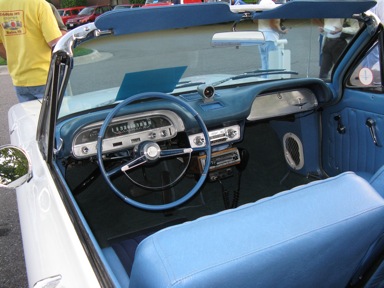 Deluxe steering wheel |
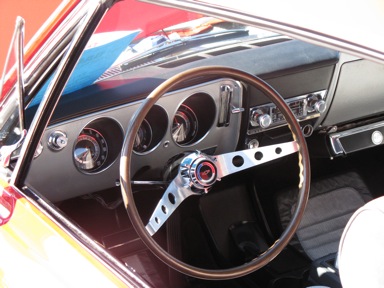 Tele column and sport wheel |
Seth Emerson has had new adapters made to allow installation of 6-bolt, factory GM "wood" wheels, Momo wheels, and 5-bolt Grant Signature series wheels on both '60 - '63 and '64 - '66 Corvairs, they accept the turn signal cam so the signals work as intended.
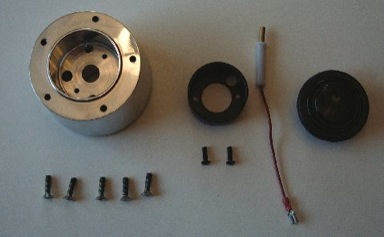 |
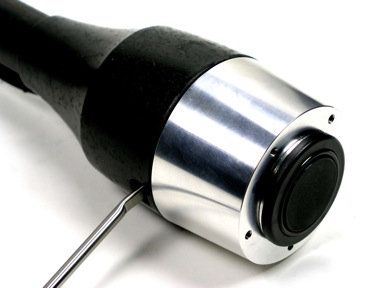 |
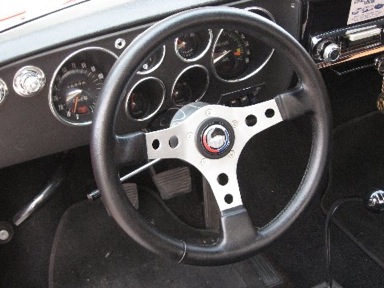 |
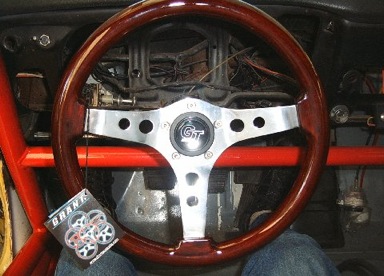 |
| Images courtesy Seth Emerson. | |
|---|---|
One thing Chevy did on the popular '65 and '66 models that makes life a little harder was switching around the wheels and columns for the tele column and fast steering boxes. The following is taken from posts by Larry Claypool and Seth Emerson:
From: Larry Claypool
1965 Corvair thru April 65 build has a 47 1/2" 1 piece steering shaft from the box to the steering wheel. The same car ordered with tele column has a small 2 bolt coupler about 4" forward of the gas tank filler neck to couple the steering box shaft and column; the steering box for this application is unique. Quick steering box was not availible in either of these earlier style configurations. Cars built after April 65 have a big bell shaped coupler right at the filler neck hoses. the bottom of the steering column has a pin going thru it at a 90 degree angle to the shaft, two bearing blocks go on here that fit into the coupler. The same steering box now used with or w/o tele column ; quick steering is now availible as a separate option. The floor pan was changed at this time as well to incorporate a reinforcement plate at the bottom of the column which helps prevent rearward displacement during a collision. The bolt pattern to the floor is different than early 65. 66 corvairs use the same set up as late 65. An early 65 tele column (identifiable by splines at the lower end instead of the cross pin of the later style) is not worth alot unless you have the early 65 steering box to go with it.
larry claypool
From: Seth Emerson
The following question was posted to Virtual Vairs:
<< XXXXXXX is selling a 65 Telecolumn and Wheel. So may I ask a couple of
questions:
1) Will this fit my EARLY 65 car? I went back through the saved V.V.
answers on this and it seems a little vague.
2) Don't you also need the special telecolumn steering box for 65's?
>>
Seth's answer:
1965-1966 Corvairs had 4 styles of steering wheels available. There were two types of "Wood" wheels, (I will refer to these as wood, even thought hey are plastic rims), and two types of plastic painted wheels. Each type, Wood and Plastic, came in both adjustable and non-adjustable type of column. (Hence the four types of wheels.) The plastic-wheel adjustable column was only offered in 1966, the other three were offered throughout 65 and 66. The non-adjustable wood wheel, referred to as the Sport Wheel option, was just a wheel option. It used a special tall center hub with the Wood wheel and had the same size spline as the non-adjustable wheel for 1965-66. The wheel and hub can be swapped onto any 65 or 66 steering column, except those with the telescoping feature. The reason for the tall hub was that the much shallower wheel would have been located too far from the driver if used with a normal hub. The telescoping column used an upper spline that was larger than the normal 65-66 spline. The actual spline was common to many other GM cars, then and now. The adjustable wood wheel and the adjustable plastic wheel are interchangeable, as long as the adjustment hardware is swapped along with the wheel. The column interface to the wheel is identical.
There were four different steering columns used in 1965-66. Until May of 1965, the standard, non-telescoping column #1 used a 47 1/2" one-piece steering shaft that extended from the inside of the steering gearbox ending at the point where the steering wheel bolted-on. The steering column used with this shaft could be removed separately from the shaft, after unbolting from the dash, steering wheel and firewall. Column #2 was also used until the May 1965 changeover. It was part of the telescoping column option. As installed in those early 65 cars, the column and steering box were separate parts, connected by a cast steel coupling about 18 inches out of the steering box. This coupling had two bolts, was splined at both ends and created a virtual solid column. This combination, including the box, the column and the wood wheel, can be swapped as is into any early 1965 car. If the car had an original one-piece column, the solid coupled telescoping system will bolt in.
In May of 1965, Chevy changed both of the steering column designs for the Corvair. (#3 & #4) This re-design was to remain through the end of the 1966 model year. A new coupling, about 2" in diameter was designed to attach the Steering column to the Gearbox. From this point on, through 1966, all of the steering gears appear identical. (This, however, is the point that the quick ratio steering boxes appeared.) Both telescoping and non-telescoping columns used this coupling. The part of the coupling that slides onto the steering gear has the same internal spline as the coupling used on the early telescoping system. The shaft coming out of all of the 66 style steering gear boxes is 1" longer than the shaft on the 1965 telescoping gearbox, however, so the coupling in actually located in a slightly different position. The 66 style coupling is a complex little system, and should be kept together to avoid losing any parts. Often times the coupling will be disassembled (via a large snap ring) to remove the column, in lieu of removing the lower bolt that attaches is to the steering gear shaft. If you do this, take the time to reassemble the coupling to keep dirt out of it and retain all the parts.
Interchangeability. It is better to swap all the appropriate parts from a complete system into another car. The column mounting flange, as well as the bolt pattern where the column exits the passenger compartment and passes into the steering area differs between the early 65 and the late 65-66 style. This flange is loose on the column shaft on the 65 style and is fixed to the column on the 66 style. Conversely, the clamp which attaches the column to the underside of the dash also differs.
To identify an early 65 column, just look under the dash where the column goes into the firewall. If the flange/bracket clamps around the column with a large bolt, it is a 65. If it is tack-welded onto the column at the firewall, it is a late 65-66.
The floor can be adapted to allow interchange. The most common swap is adding a telescoping column from an early style to a 66-style gearbox. In this case, the 1" longer shaft of the later gearbox spaces the whole column 1" closer to the driver. The flange at the floor will take some adaptation, hole drilling and sealing. Don't let water enter here. If you are doing this swap, be sure to remove the "Nut-plate" from the front side of the 66 firewall, when you get the column. That is where the bolts for the column screw into.
Also, the fixed clamp at the dash will end up missing the original mounting holes. If you are creative, and don't want to remove and re-attach the clamp, you can carve a section from the bottom of the clamp and line up the half-moon shaped area right over the mounting holes. Use some heavy-duty washers over the holes and it will work. You could also remove the 65 mounting ears and use parts from the 66 column to clamp it in place. Note that this allows you to use the early telescoping column with the fast steering box, which was only readily available in the 66-style gear. Electrically, the columns are interchangeable, although wire colors changed from 65 to 66. - Well - Enjoy your swap. Don't commit the worst of sins, stripping off the telescoping wheel parts from a junker, leaving the rest of the column to be crushed. Go for the whole column. You'll be glad you did.
Seth Emerson
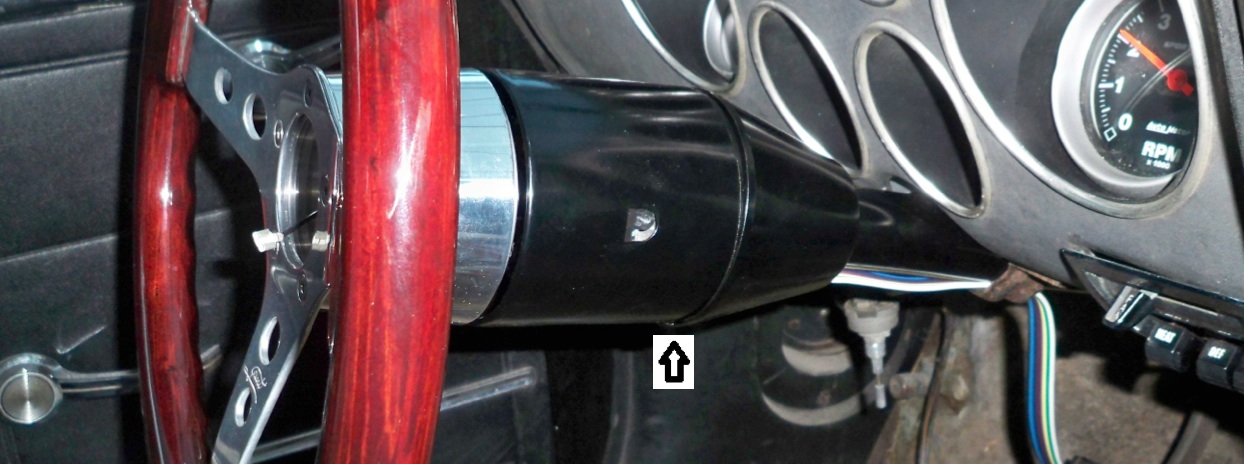
At the 2014 Performance Workshop, Seth gave a presentation on installing an aftermarket Flaming River tilt steering column intended for a Corvette in a late model Corvair:
All the splined ends are the same, but there are four different shaft lengths of Corvair steering boxes:
Be aware that the '64 one piece shaft is about 49" long and the early (up to April) '65 shaft is about 47 1/2" long.
Some more good info from Seth, on the Flaming River aftermarket steering box.
Well - I just came inside after a half hour out in my non-heated garage (okay - at 55 degrees) and I did some measuring of steering boxes. Someone had asked about the comparative sizes of the new Flaming River box and the stock Corvair boxes. I had a 1962, aluminum box, a 1966 mid-length shaft box, a 1967 short shaft box, and the flaming river "quick" ratio new box. The output spline for the pitman arm is the same on all of them. (I didn't remove and re-install an arm, they just look identical.) The input spline for the 1967 (same 67-69) had the same length as the Flaming River unit. The only difference is the small flat on one side of the spline. That would have to be duplicated to install the box into a 67-69. Maybe 3 minutes with a grinding wheel. Do a trial fit-up with a spare stamped coupling. The spline on the 62 is the same as the Flaming river unit - no flat ground on it. It should bolt into a 60-63 car (some 60s are different, big surprise!) It will be much heavier than the stock box - the early ones were aluminum, the Flaming River unit is steel. It is also much stronger. The 66 boxes and any 64-65 box will take some work to adapt to the Flaming River box. But it can be done. A spline adapter and an extension will do it. Careful with the welds!
Ratios - I turned all the boxes through their complete travel. The 66 box (a factory quick ratio), was 3.6 turns lock to lock. The pitman arm shaft turned about one quarter of a turn. That is the 16 to one ratio. The Flaming River box turned a little more than 4 turns, say 4.1 - but the Pitman arm turned more than the quarter turn. I think the ratio is the same as the factory fast box. The 62 box and the 67 box both went over 5 turns lock to lock - and performed the same one-quarter turn on the pitman arm. It is worth noting that the steering box, when fully installed in the car and hooked up to the steering components does not approach lock in either direction. Other components - steering arms, usually - prevent the box from reaching the ends of travel.
Seth Emerson
Since the steering arms on a Corvair unbolt from the spindle, making faster ratio arms has been a product almost from the introduction of the car. The photo below (courtesy JR Read) is of a display Mike Harrison of Group Corvair had at a convention vendor area. Keep in mind that the ratio is based on the distance from the spindle to the tie rod mount, so the changes look bigger than they are because of the mounting holes. The 'factory fast" arms were matched to the fast ratio box and have forging numbers ending in 417 and 418. Standard ratio arms end in 467 and 468. The "typical short" is an example of arms sold by IECO, EELCO, etc. - they are cast and can be easily identified by the thicker section at the tie rod hole. I do not know the origin of the 'really short" arms.

|